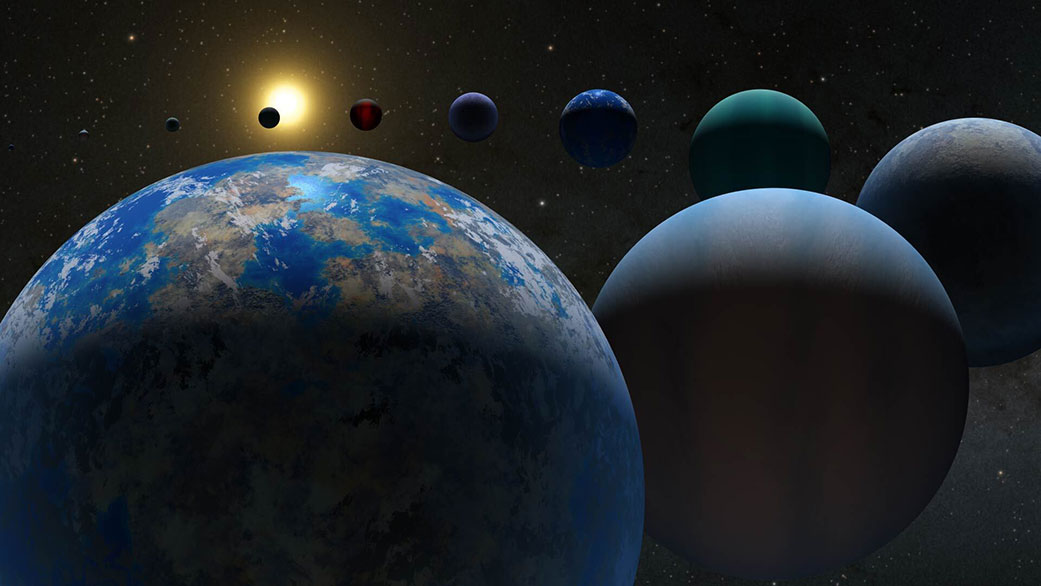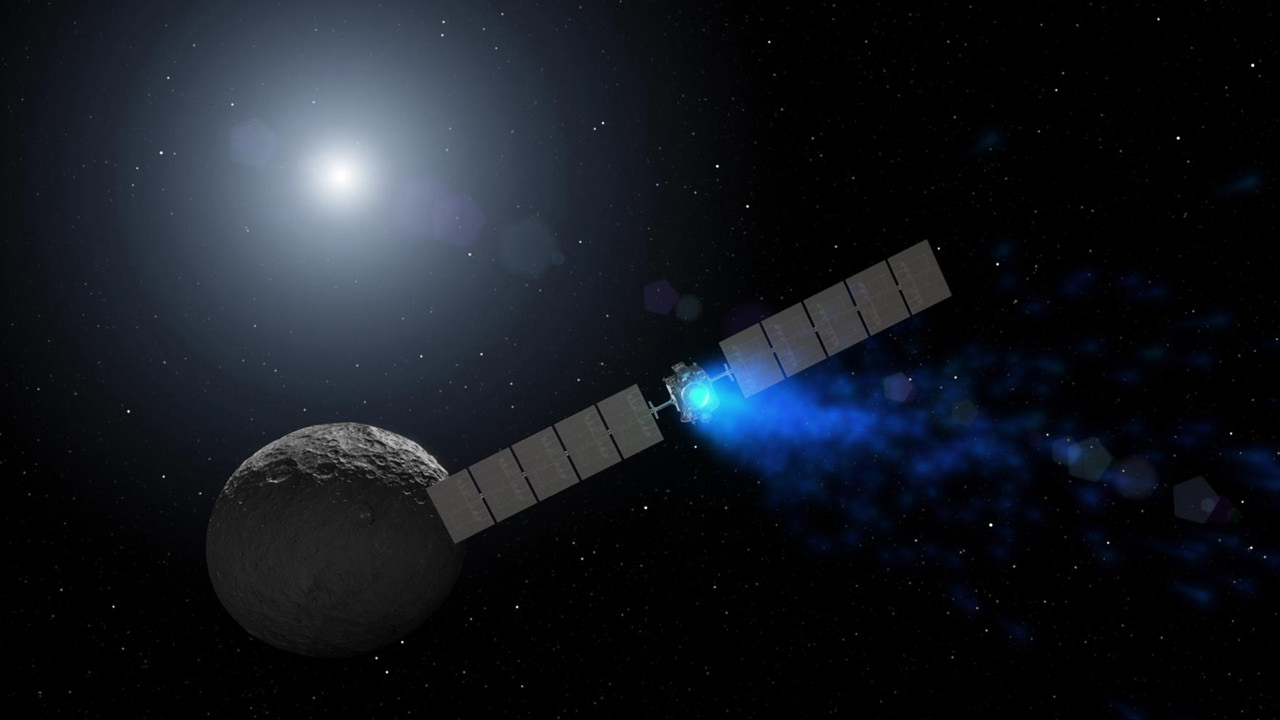It was 1969 that humans first set foot on the Moon. Now, over 50 years later we are setting sights on building lunar bases. The ability to complete that goal is dependent on either transporting significant amounts of material to the Moon to construct bases or somehow utilising raw lunar materials. A team of Chinese researchers have developed a technique to create bricks from material that is very similar to the soil found on the Moon. The hope is that the lunar soil can in the future, be used to build bricks on the Moon.
Continue reading “Building Bricks out of Lunar Regolith”New Research Reveals Provides Insight into Mysterious Features on Airless Worlds
Between 2011 and 2018, NASA’s Dawn mission conducted extended observations of Ceres and Vesta, the largest bodies in the Main Asteroid Belt. The mission’s purpose was to address questions about the formation of the Solar System since asteroids are leftover material from the process, which began roughly 4.5 billion years ago. Ceres and Vesta were chosen because Ceres is largely composed of ice, while Vesta is largely composed of rock. During the years it orbited these bodies, Dawn revealed several interesting features on their surfaces.
This included mysterious flow features similar to those observed on other airless bodies like Jupiter’s moon Europa. In a recent study, Michael J. Poston, a researcher from the Southwest Research Institute (SWRI), recently collaborated with a team at NASA’s Jet Propulsion Laboratory to attempt to explain the presence of these features. In the paper detailing their findings, they outlined how post-impact conditions could temporarily produce liquid brines that flow along the surface, creating curved gullies and depositing debris fans along the impact craters’ walls.
Continue reading “New Research Reveals Provides Insight into Mysterious Features on Airless Worlds”New Simulation Will Help Future Missions Collect Moon Dust

In this decade and the next, multiple space agencies will send crewed missions to the Moon for the first time since the Apollo Era. These missions will culminate in the creation of permanent lunar infrastructure, including habitats, using local resources – aka. In-situ resource utilization (ISRU). This will include lunar regolith, which robots equipped with additive manufacturing (3D printing) will use to fashion building materials. These operations will leverage advances in teleoperation, where controllers on Earth will remotely operate robots on the lunar surface.
According to new research by scientists at the University of Bristol, the technology is one step closer to realization. Through a virtual simulation, the team completed a sample collection task and sent commands to a robot that mimicked the simulation’s actions in real life. Meanwhile, the team monitored the simulation without requiring live camera streams, which are subject to a communications lag on the Moon. This project effectively demonstrates that the team’s method is well-suited for teleoperations on the lunar surface.
Continue reading “New Simulation Will Help Future Missions Collect Moon Dust”Establishing a New Habitability Metric for Future Astrobiology Surveys

The search for exoplanets has grown immensely in recent decades thanks to next-generation observatories and instruments. The current census is 5,766 confirmed exoplanets in 4,310 systems, with thousands more awaiting confirmation. With so many planets available for study, exoplanet studies and astrobiology are transitioning from the discovery process to characterization. Essentially, this means that astronomers are reaching the point where they can directly image exoplanets and determine the chemical composition of their atmospheres.
As always, the ultimate goal is to find terrestrial (rocky) exoplanets that are “habitable,” meaning they could support life. However, our notions of habitability have been primarily focused on comparisons to modern-day Earth (i.e., “Earth-like“), which has come to be challenged in recent years. In a recent study, a team of astrobiologists considered how Earth has changed over time, giving rise to different biosignatures. Their findings could inform future exoplanet searches using next-generation telescopes like the Habitable Worlds Observatory (HWO), destined for space by the 2040s.
Continue reading “Establishing a New Habitability Metric for Future Astrobiology Surveys”China Releases its First Roadmap for Space Science and Exploration Through 2050.
China’s space program has advanced considerably since the turn of the century. In addition to developing heavy-launch vehicles like the Long March 5 and building a modular space station in orbit, China has also embarked on an ambitious program of lunar exploration (Chang’e) – which has launched six robotic missions to explore the Moon’s surface since 2007. These missions are paving the way for crewed missions to the Moon by 2030 and creating a permanent habitat around the Moon’s southern polar region – the International Lunar Research Station (ILRS).
They also plan to send crewed missions to Mars by 2033, which will culminate in the creation of a permanent base there too. Earlier today, the Chinese Academy of Sciences (CAS), the China National Space Administration (CNSA), and the China Manned Space Agency (CMSE) jointly released the country’s first long-term scheme for space science and exploration. Titled “National Medium—and Long-Term Development Plan for Space Science (2024-2050),” this plan elaborated on the basic principles, development goals, and roadmap for the country’s space science and exploration through 2050.
Continue reading “China Releases its First Roadmap for Space Science and Exploration Through 2050.”Space Force’s X-37B will Perform “Never Before-Seen Maneuvers” in Orbit

The X-37B Orbital Test Vehicle (OTV) has been shrouded in mystery since its maiden flight in 2011. Designed by Boeing and operated by the U.S. Space Force (USSF), this remotely operated, reusable space plane is designed to operate in Low-Earth Orbit (LEO), 240 to 800 km (150 to 500 mi) above the Earth, and test reusable vehicle technologies that support long-term space objectives. On December 29th, 2023, the X-37B began its seventh mission (OTV-7) and has reportedly been conducting experiments on the effects of space radiation and testing Space Domain Awareness (SDA) technologies.
As part of this mission, the X-37B will soon begin executing a series of novel maneuvers to change its orbit around Earth. These maneuvers will consist of the spacecraft brushing against Earth’s upper atmosphere to shed speed and lower its orbit without expending much fuel—a technique known as “aerobraking.” This is the first time the X-37B has performed such a maneuver, which will help it evade detection by potentially hostile nations and perform undetected low passes over Earth during future missions.
Continue reading “Space Force’s X-37B will Perform “Never Before-Seen Maneuvers” in Orbit”Europa Clipper Begins Odyssey to Assess Jovian Moon’s Habitability

NASA’s Europa Clipper spacecraft today began its six-year cruise to the Jupiter system, with the goal of determining whether one of the giant planet’s moons has the right stuff in the right setting for life.
The van-sized probe was sent into space from NASA’s Kennedy Space Center atop a SpaceX Falcon Heavy rocket at 12:06 p.m. ET (16:06 UTC). A little more than an hour after launch, the spacecraft separated from its launch vehicle to begin a roundabout journey of 1.8 billion miles (2.9 billion kilometers) from Earth orbit to Europa.
For decades, scientists have been collecting evidence that Europa harbors a hidden ocean of salty water beneath its icy shell. Or are they hidden lakes? Europa Clipper is built to characterize the moon’s surface, and what’s beneath that surface, to an unprecedented degree.
Continue reading “Europa Clipper Begins Odyssey to Assess Jovian Moon’s Habitability”Webb Observations Shed New Light on Cosmic Reionization

The “Epoch of Reionization” was a critical period for cosmic evolution and has always fascinated and mystified astronomers. During this epoch, the first stars and galaxies formed and reionized the clouds of neutral hydrogen that permeated the Universe. This ended the Cosmic Dark Ages and led to the Universe becoming “transparent,” what astronomers refer to as “Cosmic Dawn.” According to our current cosmological models, reionization lasted from 380,000 to 1 billion years after the Big Bang. This is based on indirect evidence since astronomers have been unable to view the Epoch of Reionization directly.
Investigating this period was one of the main reasons for developing the James Webb Space Telescope (JWST), which can pierce the veil of the “dark ages” using its powerful infrared optics. However, observations provided by Webb revealed that far more galaxies existed in the early Universe than previously expected. According to a recent study, this suggests that reionization may have happened more rapidly and ended at least 350 million years earlier than our models predict. Once again, the ability to peer into the early Universe has produced tensions with prevailing cosmological theories.
Continue reading “Webb Observations Shed New Light on Cosmic Reionization”A Possible Exomoon Could be Volcanic, like Jupiter’s Moon Io

In 2012, astronomers detected a gas giant transiting in front of WASP-49A, a G-type star located about 635 light-years from Earth. The data obtained by the WASP survey indicated that this exoplanet (WASP-49 b) is a gas giant roughly the same size as Jupiter and 37% as massive. In 2017, WASP-49 b was found to have an extensive cloud of sodium, which was confounding to scientists. Further observations in 2019 using the Hubble Space Telescope detected the presence of other minerals, including magnesium and iron, which appeared to be magnetically bound to the gas giant.
WASP-49 b and its star are predominantly composed of hydrogen and helium, with only trace amounts of sodium – not enough to account for this cloud. In addition, there was no indication of how this sodium cloud was ejected into space. In our Solar System, gas emissions from Jupiter’s volcanic moon Io create a similar phenomenon. In a recent study, an international team led by scientists from NASA’s Jet Propulsion Laboratory found potential evidence of a rocky, volcanic moon orbiting WASP-49 b. While not yet confirmed, the presence of a volcanic exomoon around this gas giant could explain the presence of this sodium cloud.
Continue reading “A Possible Exomoon Could be Volcanic, like Jupiter’s Moon Io”NASA Announces a New Class of Space Missions: Probe Explorers
NASA has sent a whole host of spacecraft across the Solar System and even beyond. They range from crewed ships to orbit and to the Moon to robotic explorers. Among them are a range of mission classes from Flagships to Discovery Class programs. Now a new category has been announced: Probe Explorers. This new category will fill the gap between Flagship and smaller missions. Among them are two proposed missions; the Advanced X-ray Imaging Satellite and the Probe Far-Infrared Mission for Astrophysics.
Continue reading “NASA Announces a New Class of Space Missions: Probe Explorers”



